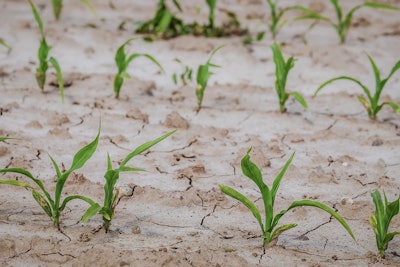
Recent weather patterns have brought mixed drought conditions across the United States. Significant rainfall has eased dryness in the Southeast and Northeast, while key agricultural areas in the Midwest and High Plains face expanding or intensifying drought, according to the latest U.S. Drought Monitor report. The report is a joint production of the National Drought Mitigation Center at the University of Nebraska-Lincoln, the U.S. Department of Agriculture (USDA), and the National Oceanic and Atmospheric Administration (NOAA).
Widespread precipitation delivered relief to several regions:
- Southeast: Experienced heavy rainfall, with totals ranging from 2 to 10 inches (1 to 8 inches above normal, and up to 600% above normal in some areas). This led to widespread drought improvements. Severe drought (D3) was removed from northern Florida, and improvements to moderate to severe drought (D1-D3) and abnormal dryness (D0) occurred across much of the state. Severe drought (D2) improved along the Carolina Coast.
- Northeast: Received 1 to 4 inches of rain above normal, with the heaviest totals (3 to 5 inches) in parts of eastern Pennsylvania, New York, and New England. This resulted in the removal of severe drought (D2) in southern New York and northern New Jersey, and improvements to moderate and severe drought (D1-D2) elsewhere in the region.
- South: Saw cooler temperatures and varied precipitation, with heavy amounts (1 to 8 inches) in Louisiana, Mississippi, and parts of Oklahoma, Texas, and southern Arkansas. This led to improvements in moderate to exceptional drought (D1-D4) in Texas and moderate to severe drought (D1-D2) in western Oklahoma.
Conversely, other significant agricultural areas saw drought conditions worsen:
- Midwest: Faced above-normal temperatures, with departures up to 20 degrees F above normal in northern Minnesota. Precipitation was below normal across much of the region, with some areas receiving 50% or less of normal rainfall over the past 30 days. Growing precipitation deficits led to the expansion of moderate drought (D1) and abnormal dryness (D0) in central Minnesota, southern Wisconsin, Michigan, Iowa, and northern Missouri, Illinois, and Indiana.
- High Plains: Experienced warm temperatures, especially in the north (up to 20 degrees F above normal). While beneficial heavy rain (1 to 3 inches) improved conditions in eastern Colorado and Kansas, dry conditions elsewhere resulted in the introduction of extreme drought (D3) in western Nebraska and expansion of moderate to extreme drought (D1-D3) in western Colorado and eastern Nebraska.
- West: Showed a mixed pattern. Improvements included reduction of exceptional drought (D4) along the Nevada-Arizona border and extreme drought (D3) in parts of Utah, Nevada, California, and Arizona. However, above-normal temperatures and below-normal precipitation led to the expansion of exceptional drought (D4) in southern New Mexico, severe drought (D2) in Montana, and moderate drought (D1) in northern Washington, Idaho, and Montana.
In the Pacific:
- Hawaii: Kauai and Oahu saw drought improvements due to enhanced showers. In contrast, Maui and the Big Island experienced drought expansion because of missed precipitation, low streamflows, and declining vegetative health.
- Northern Marianas: Conditions persisted or deteriorated. Saipan remained in extreme drought (D3), while Rota and Guam were downgraded to severe drought (D2). Farmers reported serious crop stress in some areas.
Looking ahead, the forecast for May 13-17, 2025, indicates heavy rain for the Dakotas and Minnesota, with very warm weather (highs 85-90 degrees F) continuing across the Upper Midwest before shifting eastward. Southern Texas is expected to see highs exceeding 100 degrees F. The Climate Prediction Center’s 6-10 day outlook (May 18-22, 2025) favors above-normal precipitation for most of the U.S., except for parts of the West Coast and the Florida Peninsula.
















